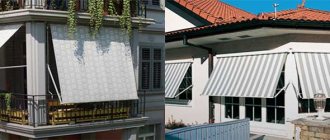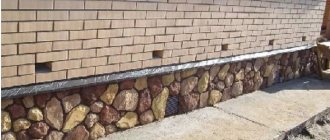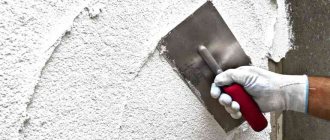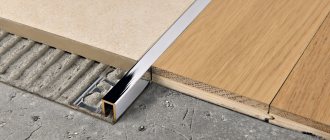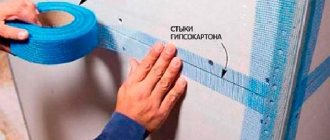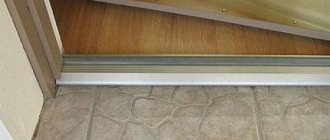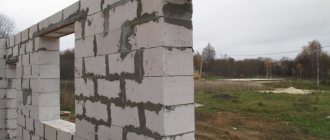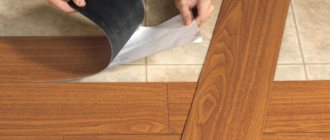Due to the movement of soil layers, the entire structure tilts, now in one direction, then in the other.
But the building itself stands solidly, thanks to a good foundation. If a crack appears in the wall of a house, this may mean that the foundation is doing its job very poorly. But there are many other reasons why cracks can occur even without the foundation being destroyed.
What to do
There are a couple of steps you need to take to fix the cracks. Process sequence to resolve the problem:
- Use the contacts of the management organization and call them. Call an expert. He will inspect the property and issue a specific inspection report. It is better to ask for help through a formal statement;
- after the expert arrives, you will see the inspection report. The causes of cracks will be recorded;
- Tell the company employees to inspect the quality of the foundation. The source of the problem must be found;
- if the crack occurred due to the fault of the management company, workers will carry out repairs. If the problem begins to develop due to the influence of the owner, responsibility passes to him.
If cracks appear due to the company building the structure or due to the management company, money for repair work is collected from these organizations.
If the neighbors above you flooded, which is why the cracks appeared, they must pay for the repairs. In other options, the restoration is carried out and paid for by the homeowners.
Required tools and materials
To seal cracks you will need the following material:
- wood glue in the consistency of thin sour cream, mixed with tooth powder or chalk chips;
- strips of cotton fabric, gauze, medical bandage, soaked in PVA glue (they can be replaced with fiberglass tape);
- cement mortar mixed with paint prevents moisture penetration;
- lime-cement mortar reinforced with mesh;
- sandpaper for grouting;
- primer;
- sealant;
- putty mixture;
- polyurethane foam;
- plaster for finishing.
- brush;
- brush;
- putty knife;
- construction mixer;
- foam sponge;
- gun for sealant and polyurethane foam.
In some cases, the work will additionally require a hammer, chisel and a hammer drill with attachments.
Drawing up an application to the management company
Many people are interested in filing an application with the Criminal Code. There is no standard sample documentation, but there is certain information that must be in the application:
- the initials of the company director are indicated;
- personal information of the client, methods of communication with him (phone number, mail);
- if there are any errors, the application may be rejected;
- the essence of the application, the problem that arose. Complaints that indicate violations of regulations and laws are approved.
What else is stated in the document:
- information about the company, its location and information about the director;
- information about the client, name, contact information, place of residence, title of the document being submitted (complaint, application);
- the situation due to which the statement is being written;
- a request to resolve the problem, what solutions the client expects from the company;
- date of application, signature;
- It's better to attach real evidence. Attach a photo of the cracks in the wall;
- indicate the required dates, personal information, contacts and signature.
There are two ways to submit an application:
- make several analogues of the documentation . Take one to the Criminal Code. The secretary must take the document and identify the entry with the date of consideration of the application. In case of refusal, it is worth saving time and moving on to another method;
- find all bills for the last month. They have the company's mailing address. You can send your application by email.
This is all the basic information you will need.
How dangerous?
If a multi-storey building burst and repair work was not carried out on time, then the crack is dangerous due to a large discrepancy. To determine the level of danger, it is necessary to position the control clamp, observing the condition of the seam. If it is difficult to deal with the problem of damage to brick walls yourself, then call a specialist. The specialist has special plate-type beacons, which are registered with the supervisory authorities. If it is impossible to call the technician, perform the following actions:
- In the place where the brick breaks, glue a paper strip, indicating the date of its fixation.
- Use cement mortar to make a small horizontal strip over the crack that appears.
Regularly check the condition of the control beacon. Sometimes it remains unchanged even after 2-3 months. On average, it takes a year to fully assess the condition of a brick wall. The damage to the controller shows how dangerous the crack is. If it breaks, it is necessary to tighten the walls of a brick house using technical solutions.
If the control beacon remains undamaged, then there is no need to worry and it will be enough to just hide the defect by covering it with plaster along the formed seams.
Where to contact
If cracks are detected, contact the management company. If the organization does not want to carry out and pay for repairs, it is necessary to go to the administration of the management company. In any case, the answer will come in writing. If the complaint is not considered there, you can call higher services:
- to the department of construction in the city;
- to the official housing inspection;
- to the prosecutor's office;
- to the judiciary;
- to Rospotrebnadzor.
Filing an application to the judicial authorities is the last step. To resolve the problem, the client must file a lawsuit against the companies that refused to restore and repair cracks in the walls. According to the law, complaints can be filed with a variety of organizations at once.
An inspection report must be attached to the complaint. If it was not carried out due to the refusal of the management company, you have the right to call an employee from special organizations.
ATTENTION! It is also necessary to provide photographs showing how the walls are cracking or documents of refusal of management companies.
Is it possible to build a house if the foundation is cracked?
It depends on the size of the cracks. If their diameter is 0.1-0.3 cm, then it is enough to cover the gap with mortar and continue construction. Horizontal cracks are not dangerous, since they do not affect the integrity of the base. But the formation of vertical ones indicates a violation of the pouring technology, so erecting a structure is a waste of effort, time and money. Soon the house will sag or simply collapse under the influence of external factors. The best solution in this case would be to refill the damaged area, carefully following the technology.
Causes
In new multi-apartment buildings, problems with the quality of walls periodically arise. Faults and cracks appear in the ceiling and other places. Reasons why cracks appear in the house:
- the structure was poorly constructed;
- the soil has settled poorly;
- heavy load on the foundation of the building;
- frequent flooding with liquid from neighbors, leaking house;
- the soil has changed since the house was built;
- the wall is drying out;
- winter and cold, freezing of structures, poor-quality heating system.
Small cracks in the walls cannot be ignored. It is much easier and cheaper to eliminate them while they are small. As the size increases, it becomes more difficult to correct the problem.
Peculiarities
The appearance of cracks on brick wall surfaces is a bad sign. However, if the foundation is laid correctly and the masonry is done correctly, cracks should not occur.
Any visible flaw indicates non-compliance with construction or use standards and requires immediate correction of the cause of its appearance. The level of difficulty in sealing cracks in wall surfaces depends on their thickness and depth (sometimes you have to dismantle the required area of the brickwork).
You can repair the crack yourself if you follow our recommendations. We will help you eliminate any defects (for example, a cracked surface of a load-bearing wall).
Varieties
There are two types of cracks in the walls of panel buildings: open and closed. The names explain the problem.
Closed defects appear inside the walls and are not visible without special equipment, but open ones can be noticed at any time. Any of these types of cracks are essentially developmental and without repair will only lead to deterioration.
You should also be careful about where a crack appears in an outer or inner wall, in a load-bearing wall or in a partition, perhaps on the ceiling or somewhere else. To independently check the risk of a split, you just need to install a plaster beacon.
If the beacon remains intact during the season, it means that the defect has not developed and can be eliminated. At the same time, the growing cracks will show their changes and will constantly grow. Stable defects are the best when considering a problem like this.
In addition, there are technological defects that arise during drying of components used in finishing and construction.
ATTENTION! To avoid this problem, they usually use different fastening materials that are similar to meshes.
These cracks will not lead to the destruction of the house, but will only change the external characteristics. If you work hard and distribute the defects in the walls into groups, you will get the following:
- For reasons: additive, deformation, temperature, design problems, and also wear and weathering.
- By destruction: shears, pressure and ruptures.
- In direction: oblique, vertical and horizontal direction.
- Shape: different contours.
- By depth: external and through cracks.
- By risk level: safe and dangerous defects.
- By time interval: stable and unstable-permanent defects.
- By disclosure: large, small, hairy, passing near the plaster, developed. To determine the causes of horizontal defects, it is worth calling an expert.
Methods for eliminating cracks
The worst case is that the crack continues to expand. This indicates that the walls or even the foundation of the structure will inevitably collapse.
To solve the problem, it is necessary to completely rebuild the broken section of the building. But if the building’s flaws are noticed in time, then you can get by in a less radical way, namely by covering the house.
It's easy to do:
It is necessary to install corners with a shelf of one hundred millimeters at the outer corners;- Smooth reinforcement is laid along the walls in two or more lines; it is supported by special devices.
- The threads are cut on the rods as follows: left on one side, right on the other;
- Nuts are screwed onto the reinforcement and welded to the corners.
- Small parallel rods are welded from the corner on the side of the reinforcing bars (about a meter away). This is necessary in order to rotate the adjustable wrench.
During the final tie, two people twist the rod at the same time, increasing the tension. With these actions, the cracks disappear completely, you just need to change the plaster of the building walls and basement.
If the markers remain intact or the cracks widen or narrow, this means that the foundation is fulfilling its purpose well, and there was tension in the wall materials that spilled out in the form of cracks.
To strengthen the wall in the emergency area, use:
- Reinforcement with carbon fiber or steel mesh on the outside;
- Metal frames or anchors;
- Reinforcing elements that are laid along grooves;
- The injection method is used.
The main action is to close the crack and restore the solidity of the structure. In the event that the brick rows were incorrectly tied and for this reason a crack formed, then the only way to eliminate the damaged area would be to redo it.
To seal cracks, you need to clean the entire length and depth of dirt and dust, then remove the layer of mortar, expanding it. The resulting gap is filled with cement mortar as a result of various manipulations, but at the same time reinforced.
Heaving and methods for its elimination
Heaving when the soil gets wet
To prevent the soil under the foundation from accumulating water and getting the soil wet, blind areas and drainage pipes are made around the building, and they are placed as far as possible from the building. But over time, the concrete screed may collapse and water will penetrate under the foundation, which will wash it away. A sign of this phenomenon is the gradual expansion of cracks, and they usually expand during precipitation.
Frost heaving
During frost heaving of the soil, the foundation of the building remains intact, but the building tilts and it is unknown how strong the next shrinkage of the building will be and how the next shrinkage will affect the integrity of the foundation.
To solve this problem it is necessary to equip a drainage system.
